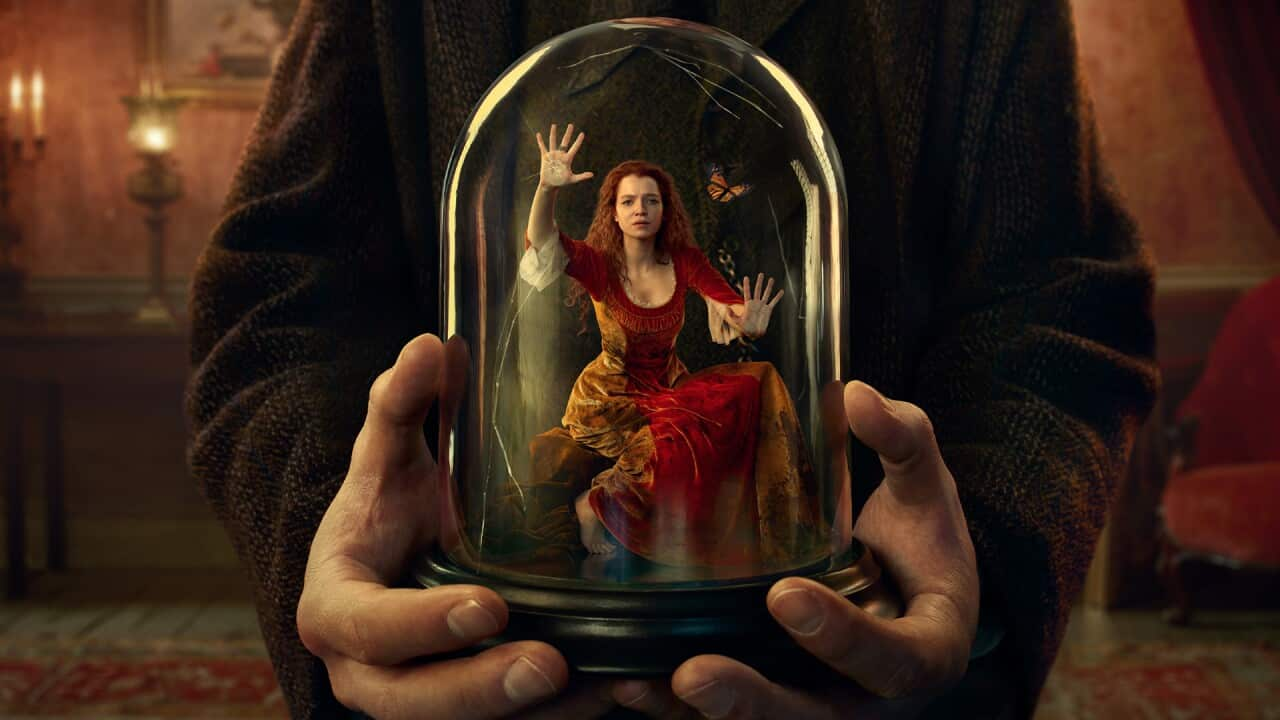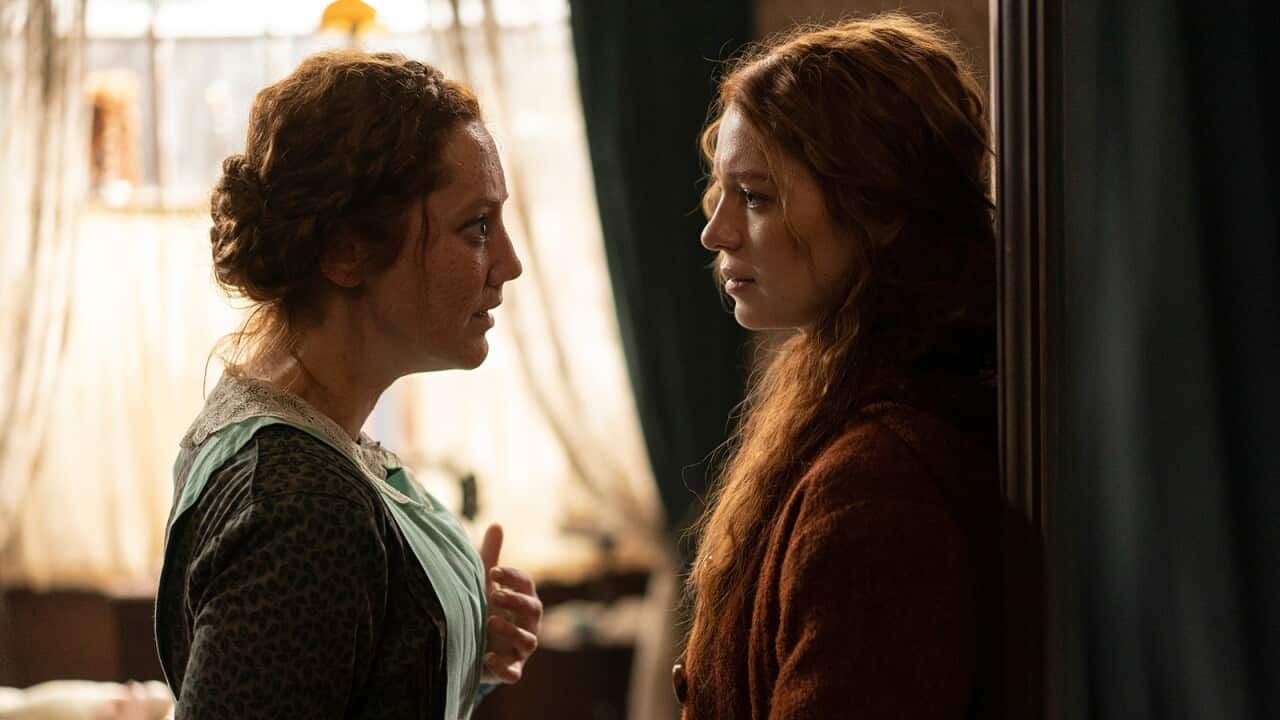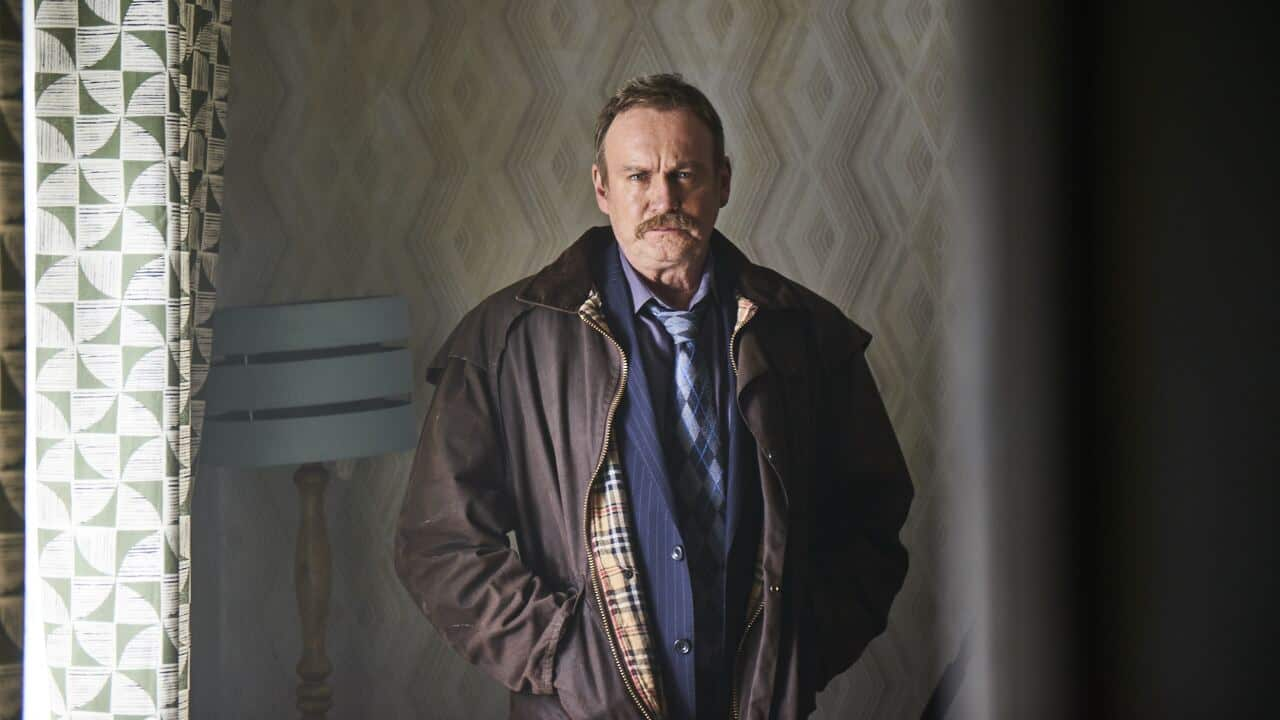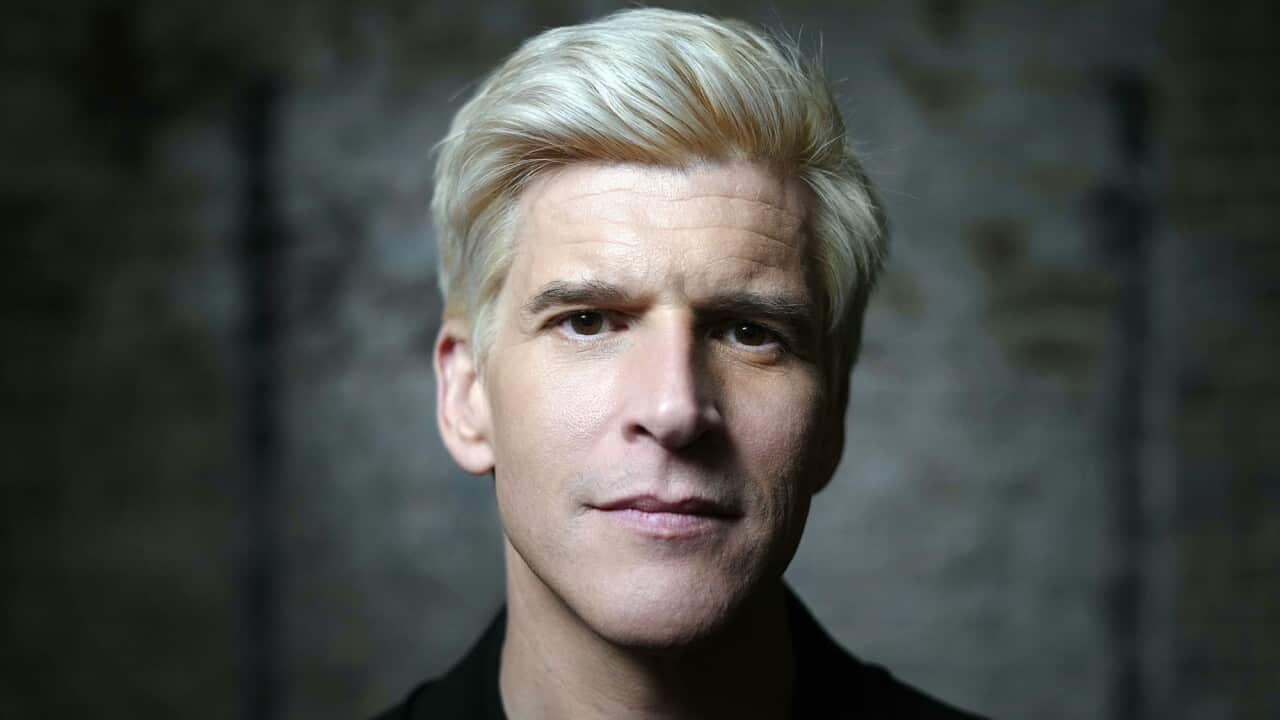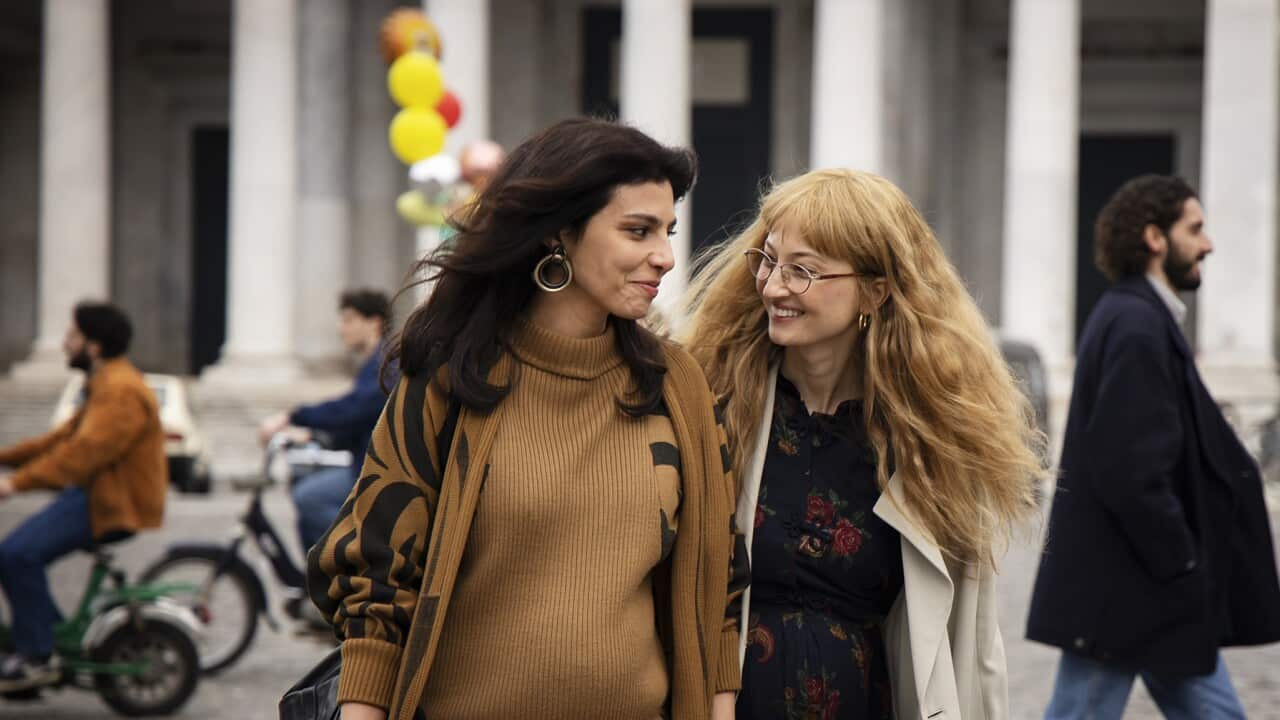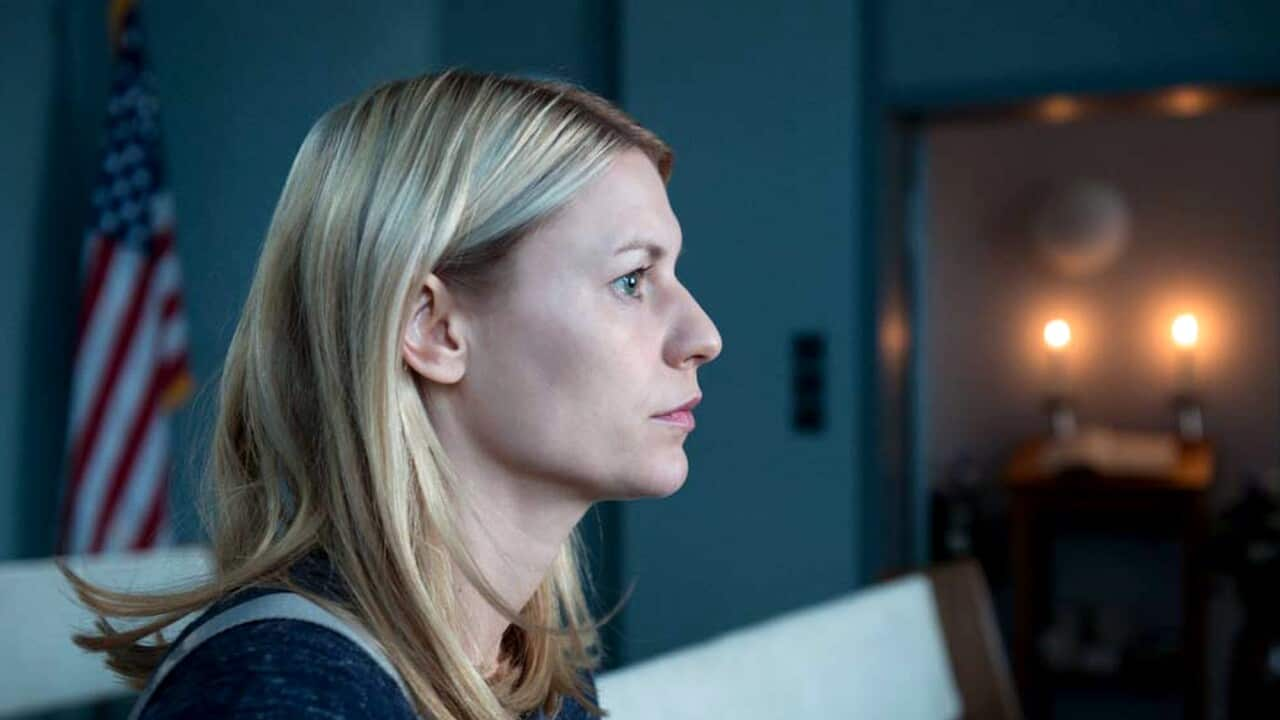Irish-filmed, dark period drama The Doll Factory, based on author Elizabeth Macneal’s award-winning debut novel, is a sumptuous visual feast, bristling with imminent doom, unbridled lust, and deadly agendas.
In the Nineteenth century, Victorian mourning dolls were a standard element of the grieving process. Their dainty porcelain faces were painted in extraordinary likeness of a dead child, sometimes embellished with the infant’s actual hair and clothing.
Twin sisters Rose (Mirren Mack) and Iris (Esme Creed-Miles) spend their days painting these dolls for bereaved families under the doleful eye of Mrs Salter. In the evenings, Iris undresses and paints her own portrait in secret. Rose secretly spies on her sister, knowing this is a dangerous undertaking and one that may end in their dismissal. It is London 1850, which is a brutal place for motherless girls.

Mirren Mack and Esmé Creed-Miles in 'The Doll Factory'. Credit: Buccaneer TV
When Iris meets Silas Reed (Eanna Hardwicke), a taxidermist and the owner of a shop of curiosities, she inadvertently becomes the source of his obsessive attentions. Uninterested in Silas’s overtures, Iris is far more concerned with Louis Frost (George Webster), a pre-Raphaelite painter. In him, her dreams of becoming a legitimate artist find a vehicle for manifestation. She figures that surely with Louis’s mentoring, she could become more than merely a cog in Mrs Salter’s gothic doll factory. She could be an artist in her own right. And so she begins to model for him, triggering a deadly jealousy in Silas, manipulation by Louis’s sister Lizzie (Hannah Onslow) and alienation from her envious sister, Rose. Sickly and pale, Rose sees all the potential of her sexual attraction embodied in her sister. In a fit of jealous rage one evening, upon finding Iris naked and painting herself, she hisses, “I was beautiful first!”
“To be painted is transformative,” Louis insists to Iris over tea with his sister Lizzie. Iris refuses at first, certain that it is too risky for herself and Rose, who are dependent on their livelihood and refuge with Mrs Salter.
She is right that it is risky, but perhaps not for her reputation so much as her survival. The seemingly handsome, harmless Louis and Lizzie are not what they first seem, which has consequences for Louis’s models. Also an issue is the fact that this is a period in which being an artist’s model is seen as akin to being a prostitute. Iris agreeing to model for Louis seals her fate in so far as she is ejected from Mrs. Salter’s “doll factory” and alienated from her sister, Rose.
“These are people clinging on in a very harsh world,” says Hardwicke, who plays the obsessive, unusual Silas. Hardwicke is effusive about Macneal’s debut novel, attributing his deep understanding and empathy for Silas to Macneal’s skill for exploring the inner monologues of characters.

Eanna Hardwicke in 'The Doll Factory'. Credit: Buccaneer TV
“I hadn't read it, but two members of my family had read it,” says Hardwicke. “So when I mentioned that I got the job [as Silas], they told me about it. I went on to read it in the audition process, and found it really helpful because the screen adaptation is very, very faithful to the book. Elizabeth writes people's inner worlds really, really well. She writes the kind of conversations you have with yourself in your head really well. There’s nothing in the novel that isn’t conveyed in the screenplay.”
The novel vividly explores every crook and crevice of Victorian era London, which both Hardwicke and Saoirse-Monica Jackson, famed for her role as Erin Quinn in Derry Girls, were impressed by. Jackson portrays Bluebell, a model for the effeminate young painter Louis.
“You've got this culture of mourning dolls, the burgeoning taxidermy industry, a mix of the deep clash of class structures, and then this really strange occult fascination at that time. The series, just as Macneal's book, has all of that, just like it has every sort of corner of the Victorian world you think you know, and then all of the ones that maybe you don't know,” Hardwicke says.

Saoirse-Monica Jackson and George Webster in 'The Doll Factory'. Credit: Buccaneer TV
Jackson adds, “The costumes and art department blew me away. The script has such a strong atmosphere on its own, and then I think the Victorian era they conjured through the sets and costumes is so magical, textured and layered. You end up anticipating every step Iris takes, and it feels exciting and dangerous.”
Though Hardwicke and Jackson are sitting side by side on a couch during our interview, Jackson admits that Hardwicke’s character only made sense to her as a sympathetic figure once filming began.
“Silas was quite hard to read,” she says. “In the book, he is so unlikeable, but I felt like watching Éanna land this character was so beautiful. It's such a testament to how much of a wonderful actor he is because, although it's so dark and there's so much evil going on there, you understand that the character’s insecurities and experiences have resulted in his actions. As an audience, you have such compassion for him, despite how dark things get.”
Hardwicke says, “It was such a grubby world. There’s a lot of beauty in the artwork that was created during that period, but it was a hard life and the production design team gave such grit to it. Within that grubby, hard world, the characters are painted in bright, vivid colours.”
It would have been easy in such a theatrical environment, like any period drama, to transform these strange characters into caricatures. It was a fine line to tread, Hardwick admits.
“In a way, these characters are drawn with big bow strokes, so there's a balance in trying to make the tone feel very natural, but to present them as normal would reduce the characters. They are all of their contradictions and their idiosyncrasies. They’re weird and brilliant, you know.”
Catch The Doll Factory, and its weird and brilliant cast of characters, now streaming at SBS On Demand.
Stream free On Demand

The Doll Factory
